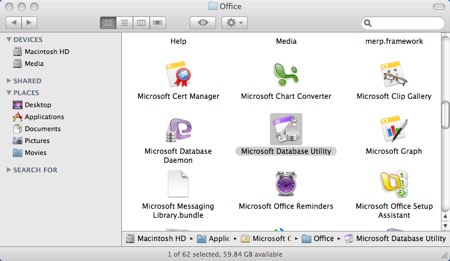Microsoft Office 2008 Mac Database Corrupt
Posted By admin On 03.04.20Apr 19, 2018 Step 2: Create a new Microsoft User Data folder The first time that you open Entourage, a new 'Microsoft User Data' folder is created in the Documents folder that is provided by the Mac operating system. The Microsoft User Data folder contains an Office 2008 Identities folder that stores the Entourage database for each identity.
- Microsoft Office 2008 Mac Database Corruption
- Microsoft Office
- Microsoft Office Database Software
- Microsoft Office Database Program
- Microsoft Office 2008 Mac Requirements
Latest Updates!
Site Navigation
- Microsoft Office for Mac 2008 may be the best pick for business users, with major updates to Word, Excel, PowerPoint, and Entourage. After a series of delays, Microsoft plans to release Office.
- Note: The ability to manually repair or rebuild a database is not available in Outlook 2016 for Mac. If a problem such as Outlook data corruption occurs, Office 2016 for Mac automatically repairs and rebuilds the Office database for you. For more information, see About the Office 2016 for Mac database.
Download updates from Office Mac or use AutoUpdate under Help in the menu bar. More Info on updates
Microsoft 2011 for mac 64 bit. Make sure that the user account you use to authenticate the update installer is an administrator account.
Support our site SIGNUP FOR HOSTMONSTER.COM
Microsoft Office 2008 Mac Database Corruption
Support our Site
Office365 Home Premium 1YR SubscriptionMicrosoft Office
Steps to re-install Office 2008

Microsoft Office Database Software
Follow these steps to reinstall: (useful when you are having problems updating)
Bulleted. For information about changing the key assignment for a keyboard shortcut, see Mac Help for your version of macOS, your utility application, or refer to.If you don't find a keyboard shortcut here that meets your needs, you can create a custom keyboard shortcut. Notes:.The settings in some versions of the Mac operating system (OS) and some utility applications might conflict with keyboard shortcuts and function key operations in Office for Mac.
Microsoft Office Database Program
- Launch the Microsoft Autoupdater (MAU).To launch MAU, you can open any Office application and select 'Check for Updates' under Help in the Menu bar. Once MAU is launched, select 'Keep in Dock'
- Quit all Microsoft applications (Easy way: log out. When you log in, hold down the Shift key. This will disable all startup items including the hidden ones. It's important all Microsoft applications are quit, but quitting all applications will result in the best results. Any open application could be corrupted by the process.
- Drag the Microsoft Office 2008 folder to the Trash.
- Empty Trash.
- Reinstall Office 2008 from your original installation disk.
- Restart ( be sure you use the same log in with Shift key down between each update)
- Early Office CDs installed 12.0.0. (Later version came with 12.1.0 or 12.2.0. You can skip to step 9) Update to 12.1.0.
- Check this file after updating to 12.1.0 to be sure it is version 2.2.0.
/Library/Application Support/Microsoft/MAU2.0
- Check this file after updating to 12.1.0 to be sure it is version 2.2.0.
- Restart (restarting before you launch any app is important!)
- Update to 12.3.0
- Restart
- If you want to upgrade to EWS for Exchange support, go to Mactopia and download the latest EWS updater. It will update the Entourage app only to v13.x. It also updates the MAU so that future updaters will also update Entourage to the latest version. See Requirements for EWS. If you do not have an Exchange account you do not need to upgrade to EWS.
Microsoft Office 2008 Mac Requirements
Note: some users have found that they need to use 'Remove Office' before re-install clears the problem. See this page for help using 'Remove Office'
I try to keep this page updated to show the latest updaters. So far Microsoft has been rolling previous updaters into a combo updater that makes updating so much easier and quicker. You can check this page for the latest updates or look in the left sidebar column under latest update.